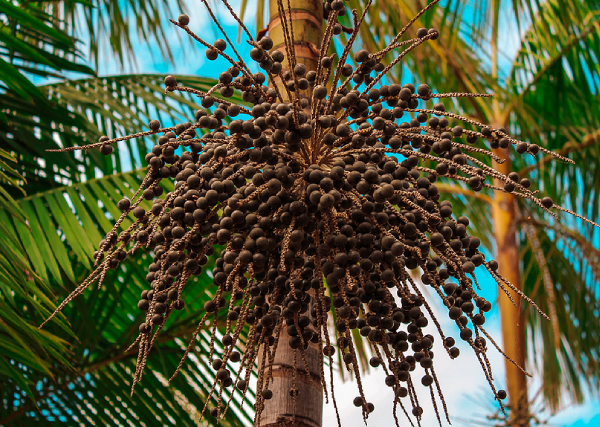In recent years, social media users have been buzzing with excitement over the açaí berry. Tiny, round, and dark purple, these berries have earned their “superfood” status due to their numerous benefits: rich in nutrients and antioxidants, they have the potential to boost your health.
Besides its remarkable nutritional profile, açaí differs from more commonly found fruits like strawberries and blueberries because it is wild harvested and, therefore, appeals to individuals concerned with maintaining a sustainable diet and lifestyle.
This article delves into the specifics of wild harvesting and how it differs from conventional farming.
Wild Harvesting vs. Conventional Farming
The main difference between wild harvesting and conventional farming is the environment from which the fruits are gathered.
As its name suggests, wild harvesting refers to fruits directly sourced from the wild. Fruits are grown naturally in an untouched environment, free from human interference. Natural processes of pollination and nutrient supply sustain such ecosystems; plants have access to clean water and unpolluted air unmarred by human touch.
On the other hand, conventional farming involves the controlled cultivation of fruits in farms. Farmers interfere with natural processes to encourage healthy and regular growth, conducting activities such as fertilisation, pest control, and irrigation. These activities help ensure the consistency of the produced fruits.
Cultivation Practices
Wild-harvested açaí berries grow in their native habitats (the Amazon forest in Brazil and Peru); the plants flourish in their natural ecosystems and contribute to biodiversity by interacting with other animals and plants. Notably, no area in the forest is cleared to plant the açaí trees—they grow amidst other native trees. The açaí palm tree can grow without human interference, which means it is not cross-bred or domesticated. Additionally, it is not planted, watered, or fertilised. As these fruits are grown in their specific ecosystems, they may possess unique characteristics specific to the environment and region that they grow in. For example, açaí berries from the East part of the Amazon will taste different from ones of the West.
As the açaí is seasonal, the locals, called “ribeirinhos” (or “river people”), only harvest the berries during the season. For the rest of the year, they work with other Amazonian naturally grown goods such as Brazil nuts and latex. This method of harvesting goods only during their season is called “forest management”. It follows nature’s natural cycles and thus guarantees the diversity of crops while respecting the local way of living.
Additionally, açaí berries are cultivated sustainably, meaning they will not clear any land to plant acai berries. The açaí seeds that drop on the floor naturally become new seedlings/trees that grow across the river. Hence, harvesters work in harmony with the environment.
As the locals have a way of gaining income from the acai berries sales, they do not leave the forest lands to look for better jobs in the cities. As they stay on the forest land, they protect it against cattle ranchers that would cut down the trees and burn them to clear ground for the cattle.
Therefore, wild harvesting practices help maintain and preserve the Amazon Rainforest’s ecosystem.
Conventional farming is a more controlled and managed process. Farmers manipulate elements like soil composition to optimise fruit size and appearance instead of clearing areas for monocultures that would require extra resources to cultivate and maintain all year round.
Environmental Impact
When performing conventional farming, farmers often use synthetic fertilisers and chemicals to promote healthy and steady growth. Many also spray pesticide to protect the crops from pests and the diseases they carry.
These practices, along with the monoculture way in which conventional farming is done, seek to optimise harvesting and yield but end up harming the environment, with chemicals polluting the soil and water, thus affecting biodiversity and soil nutrition. Moreover, chemical residues may make their way into the final product, thus posing a health risk to consumers.
Chemicals, additives, fertilisers, and pesticides are not used during wild harvesting. As such, the ecosystem is protected, allowing us access to unpolluted water and air.
Harvested Fruits
Due to the controlled nature of conventional farming, the produced fruits are typically more visually appealing. They also have a long shelf life and are highly transportable.
Some believe that wild-harvested fruits are less consistent and have a richer and more diverse flavour profile due to their natural growing conditions.
Wild Harvesting to Protect the Forest
Without sustainable açaí harvesting practices, individuals living in the forest may abandon their way of living to look for better opportunities in the city. As such, wild harvesting is an incentive for farmers to stay and protect the forest.
Conclusion
Ultimately, wild-harvested açaí berries are more environmentally friendly than conventionally-farmed fruits. Furthermore, as wild harvesting is sustainable, it allows the Amazon Rainforest’s ecosystem to remain untouched.
If you’re interested in buying açaí pulp puree, açaí sorbet ready to service, açaí popsicles, and açaí wholesale in Singapore, contact Selva Foods.
